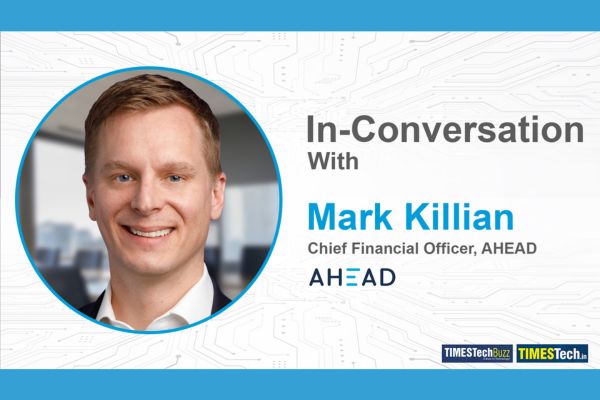In an exclusive interview with TimesTech, AHEAD’s Chief Financial Officer, Mark Killian, shares insights into the company’s financial strategies, growth initiatives, and risk management practices. With over five years at the helm, Killian discusses his role in aligning financial planning with business objectives, engaging with investors transparently, and optimizing operational efficiency for sustained success.
Read the full interview here:
TimesTech: Share a bit about your background and introduce AHEAD.
Mr. Mark: I am Mark Killian, the Chief Financial Officer (CFO) at AHEAD. I have held this position for more than five years, contributing to the financial leadership of the company. AHEAD is a prominent technology services company headquartered in Chicago, United States. With a workforce exceeding 2,700 employees, we have achieved a revenue of over three and a half billion dollars. Our rich history spans more than 15 years in the industry. Over the past six years, AHEAD has successfully executed 10 acquisitions, showcasing our commitment to growth and innovation. We have recently expanded our operations with an office in India. This strategic move aligns with our mission to deliver exceptional technology services and solutions on a global scale.
TimesTech: How do you provide strategic insights to drive growth initiative and foster partnership within the company?
Mr. Mark: In my role as the CFO, I actively contribute to shaping and executing strategic initiatives that are integral to our continuous growth. Over the past five years, we have successfully executed 10 acquisitions. My involvement in these initiatives extends from the initial stages of idea generation to the comprehensive evaluation of various alternatives. This includes determining the optimal return alternatives and assessing associated risks, positioning me on the front end of the decision-making process. My responsibilities involve conducting thorough financial analyses and leveraging data-driven decision-making practices. Through these processes, I ensure that the company is well-informed and equipped to make strategic choices that not only foster growth but also align with our risk management objectives. By actively participating in dialogues surrounding strategic initiatives, I contribute to the development of insightful and informed strategies that drive our growth and strengthen partnerships within the company.
TimesTech: What are the strategies that you use to employ for mitigation financial risk and to relate to currency fluctuation and market volatility?
Mr. Mark: The CFO’s role has significantly transformed into a focus on risk management, a crucial aspect of my responsibilities. Mitigating financial risk involves evaluating alternatives, particularly in addressing currency fluctuation and market volatility. Currency risk arises from contracts in foreign denominations or diverse cost bases in separate currencies, like in India. To manage this, we consistently explore hedging contracts to align with currencies, minimizing associated risks. Market volatility is approached by scrutinizing business trends for year-long planning and forecasting. This includes adapting to changes in interest rates through hedging instruments and active, real-time planning to navigate the dynamic market conditions effectively. Essentially, our strategies revolve around proactive risk assessment, hedging when necessary, and agile business planning to ensure financial resilience amidst fluctuating currencies and market uncertainties.
TimesTech: What is your role in aligning the financial planning and budgeting with the overarching business objective of the company?
Mr. Mark: I lead the Financial Planning and Analysis (FP&A) team, an important group that intricately connects strategic initiatives with financial analysis. Our approach to financial planning and budgeting is a comprehensive one, employing both top-down and bottoms-up methodologies. We initiate the process by examining market trends and industry dynamics to establish top-line growth targets. Subsequently, my team collaborates closely with various business units, engaging in a bottoms-up approach to develop specific objectives aligned with the overarching strategy. This involves designing compensation plans and key performance indicators (KPIs) to effectively communicate and measure progress towards our goals. We continually adapt our plans to accommodate changes in forecasts or market conditions, ensuring ongoing alignment with the company’s objectives. Essentially, my role involves orchestrating a dynamic interplay between strategic goals and financial planning, fostering cohesion and adaptability within the organization.
TimesTech: How do you actively engage with investors to instill confidence and cultivate positive relationships?
Mr. Mark: In managing our private equity-owned company and catering to a diverse investor base, transparency and active communication are very important. Our investors include financial stakeholders, lenders, debt holders, and even employees with equity or employment-based investments. Establishing confidence and positive relationships hinges on maintaining an open dialogue. We prioritize quarterly calls with external and internal stakeholders, discussing business trends, key financial metrics, and strategic considerations. This transparency extends to Town Hall meetings where we address questions from both external investors and employees. Our commitment to information flow and openness underscores our dedication to providing comprehensive insights. By consistently sharing pertinent information and proactively engaging with our investors, we foster an environment of trust and ensure that all stakeholders are well-informed about the company’s trajectory and strategic initiatives.
TimesTech: What specific measures do you take to optimize operational efficiency and ensure effective cost management in your organizational responsibilities?
Mr. Mark: In my role, a key focus is on optimizing operational efficiency and ensuring effective cost management through a metric-driven approach. When establishing budgets and annual targets, we prioritize key performance indicators (KPIs) and metrics that simplify decision-making around investments. Our strategy revolves around providing clear return metrics, making it easy for stakeholders to understand how each dollar invested benefits shareholders. These metrics often include cost as a percentage of revenue or similar benchmarks, allowing individuals to manage their specific business components in a metric-driven manner. This approach aligns their efforts with the overall objectives of the organization, fostering a culture of efficiency, accountability, and strategic alignment across the entire operational spectrum.















